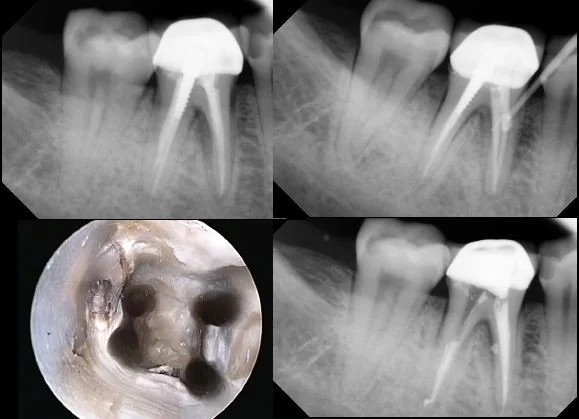Pt presented with a referral for treatment of tooth #30. Examination revealed a buccal epulis and tracing showed the pathology was associated with the mid root rather than the apex. Retreatment was recommended as the preferred treatment modality.
The decision to retreat (rather than jump straight to surgery when conronted with post treatment disease) was validated by the revealing of a lateral canal as the portal of exit associated with the epulis. At the post op examination two weeks later the epulis had fully resolved confirming the effectiveness of the retreatment.
As illustrated by the case above there are benefits to debriding and sealing the entire canal space (retreatment) rather than limiting the targetted area of debridement and sealing to the apical 3mm of the tooth (apicoectomy).
Peri-radicular pathologies, (as opposed to peri-apical pathologies) can and often do develop around lateral canals. These peri-radicular pathologies emerging from lateral canals are not uncommon, and only rarely do they have an epulis boldly announcing their presence. These secondary portals of exit are unlikely to be adressed when retreatment is bypassed in favor of an apico. While there are always exceptions, our practice philosophy is to resort to a surgical option only in the event that conventional treatment options have been exhausted.
(Side note: The determination of what presents an unmanageable blockage to orthograde treatment should be determined by an endodontist. Often times obstacles seen as insurmountable by a general dentist can often be successfully managed through orthograde treatment by an endodontist. For example, see the separated file cases shown in the rest of the portfolio.)
There is an active discussion within the endodontic specialty regarding how effectively we are able to debride and obturate these lateral canals with current treatment methods. (Some particularly excellent histological research has recently been published By Domenico Ricucci and Jose Siquiera in the JOE May 2013 and Jan 2010).
Even though the above referenced histological studies demonstrate only a limited ability to clean and obturate these lateral canals this should not be misconstrued as a license to ignore their clinical relevance. Within my own practice I continue to see repeated and predicatable resolution of peri-radicular pathologies utilizing modern irrigation techniques. These clinical observations support the contention that current irrigation protocols, while not perfect, are perhaps able to clean these lateral canals to an extent that allows for clinical resolution of pathology.
Is the ability to show consistent lateral canal fills associated with more thorough debridment and irrigation? If so, it stands to reason that those cases that display lateral canal fills may also associated with lower failure rates.

